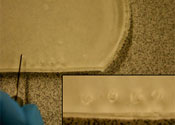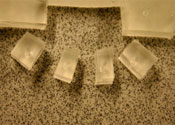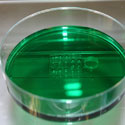Adrian O’Neill, Jeffrey Soo Hoo and Glenn Walker
Joint Department of Biomedical Engineering, University of North Carolina-Chapel Hill and North Carolina State University
Why is this useful?
A new curing procedure is presented to expedite poly(dimethylsiloxane) (PDMS) microfluidic device fabrication. For microfluidic applications, PDMS is typically cured over a master in a plastic Petri dish at 80ºC for 2.5 hours. The curing temperature is limited by the maximum temperature a plastic Petri dish can withstand without warping. Dow Corning Sylgard 184 PDMS can be cured over a range of times and temperatures, spanning ~48 hours at room temperature to 10 minutes at 150ºC. We present an alternate curing method, using an aluminium foil dish, that reduces the curing time from 2.5 hours to 10 minutes.
What do I need?
- Aluminium foil, 0.001 inch thickness or greater
- 90mm diameter crystallization dish (Pyrex 90 x 50mm)
- PDMS (Dow Corning Sylgard 184)
- Hotplate (Barnstead 721A digital hotplate)
What do I do?
1. Cut a 4.5 inch diameter circle out of aluminium foil, being careful not to wrinkle the foil. Wrinkles may tilt the master causing the thickness of the PDMS mould to vary from one side of the design to the other.
Figure 1.
2. Form the foil over the bottom of the 90mm crystallization dish, as shown in Figure 1.
Figure 2.
3. After gently removing the foil, place the master in the foil dish and put the dish on a room temperature hotplate.
4. Mix the PDMS according to the manufacturer’s procedure [1].
Figure 3.
5. Pour the desired amount of PDMS over the master, as shown in Figure 2.
6. Set the hotplate temperature to 150ºC. Once at 150ºC, cure the PDMS for 10 minutes.
Figure 4.
7. Remove the foil dish from the hotplate and allow it to cool to room temperature.
8. Gently peel or cut the aluminium foil from the master and cut away any excess PDMS (Figure 3).
9. Finally, peel the PDMS mould from the master (Figure 4).
References
[1] Dow Corning Product Information, “Information about Dow Corning® brand Silicone Encapsulants,” 2005.

































